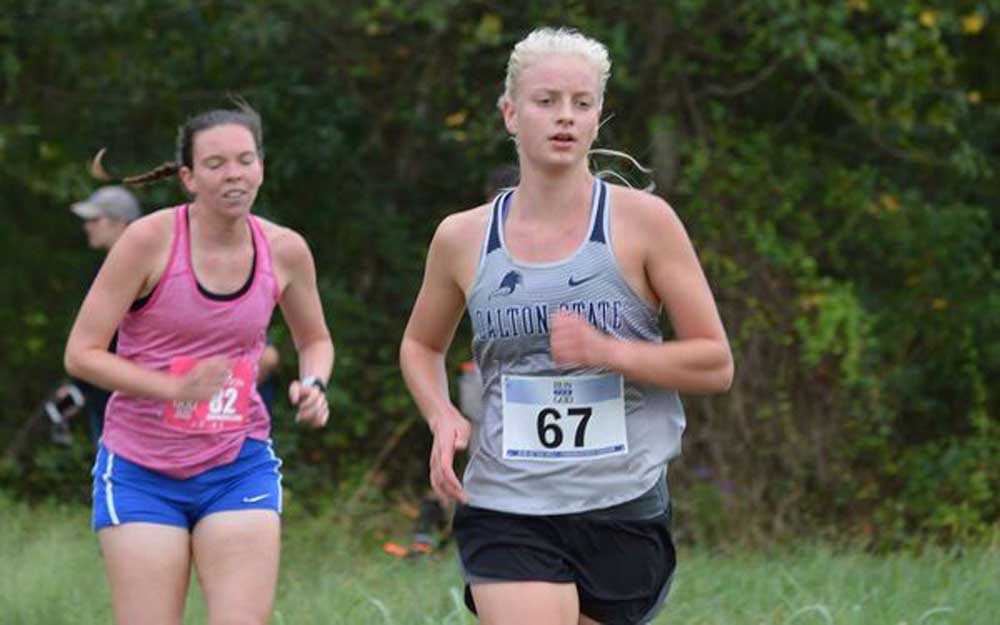Double-duty: Dalton State runners juggle overlapping track, cross country seasons due to COVID-19
Published 6:42 pm Monday, March 29, 2021

- Contributed photoDalton State College's Kathryn Vradenburgh runs in a cross country meet last year.
The COVID-19 pandemic has played scheduling havoc with sports at all levels as leagues and organizations scrambled to set up a season.
For the cross country squad at Dalton State University, that means competing in two sports at once.
Trending
“It’s really like we don’t get a break,” said Kayla Mattox, a freshman on both the cross country and track and field teams at Dalton State. “That’s what we’ve gotta do, so we’re going to try to handle it the best we can.”
The task before Mattox, and all eight members of the cross country team at Dalton State, is to gear up for the conclusion to a cross country season that began seven months ago — all while competing in track and field meets at the same time. All nine members of the cross country team are also on the 13-person track squad at Dalton State.
As part of the COVID-19 precautions levied by the NAIA, the national cross country championships were moved to spring from their usual spot in the fall semester. Individual colleges and conferences could still field a fall schedule if they wished, and that’s exactly what the Southern States Athletic Conference, of which Dalton State is a member, decided to do.
After beginning the season in September 2020, the Dalton State squad won the SSAC cross country championship in November, their fourth straight conference crown. Four months later, on April 9, the Roadrunners are set to run at the NAIA national championship meet in Cedar Rapids, Iowa.
“It certainly wasn’t something we wanted to do,” said Dean Thompson, who, like most of his runners, is pulling double-duty. He’s the coach of both the cross country and track programs at Dalton State.
“We felt like it was better to try to do things as normal,” Thompson said of the fall schedule. “Of course now, it’s months later. We’re in the middle of track season and we’re going to run a cross country race. That’s very unusual, but a lot of what we do translates. A lot of the training isn’t identical, but it’s very similar.”
Trending
The physical stress isn’t the real challenge, said Haley Tillery, a sophomore for both the track and cross country teams.
“It’s not really the physical aspect,” said Tillery, who has competed in two track meets with the Roadrunners since the season started last month. “We’re trained to run and be able to handle distances. We go on long runs that are able to prepare us. It’s more of a mental thing that you have to prepare for.”
“From a coaching standpoint, it hasn’t changed a whole lot,” said Thompson. “I think the mental side is maybe the hardest for any athlete to do. Your brain is functioning in a way that lets you endure that short-term quick, sharp pain, then you’re asking your body to shift to 20 minutes of pain. It’s hard to do.”
Cross country races are longer. The Dalton State team usually competes in 5K (3.1 mile) races. That gives a runner a lot more time to think than in the short bursts of running in a track meet, said Mattox.
“For cross country, you really just get out there and run,” said Mattox. “You’re out there on a trail, and there’s more time to think about your form and how you can pick it up. With track, it’s almost like human NASCAR. You just keep taking a left all the way around, and eventually you’ll get to the finish line. You don’t have as much time to think. You have to rely more on your training.”
“In cross country, if you don’t get a good start, you have time to recover,” Tillery said. “You have time to make up for it. In track, if you have a bad start, it can mess everything up. You can play games in your head.”
To help the cross country runners learn to flip their previously-unneeded switches between track and cross country mindsets, Thompson scheduled the team to compete in a meet earlier this month.
The team traveled to Tallahassee, Florida, to compete in a 6K meet on March 5. The team has had more problems finding 5K meets to compete in than in recent years with the scheduling turnover. The Tallahassee meet, in which the Roadrunners competed against a few NCAA Division I schools, was still helpful giving the team an idea of the adjustment they’d be facing toggling between the sports, Thompson said.
“The whole idea was to get the girls used to switching those gears back into cross country,” said Thompson. “It’s a lot like riding a bike. You know what it’s supposed to feel like, and you can go back to it. But doing it was important, at least once, to get used to it.”
The team still has to switch those gears back into track setting for a meet on Friday in Owensboro, Kentucky. Then, they’ll prepare again for the cross country nationals the following week.
Once that’s done, the nine double-dipping runners can settle into a track-only schedule for the remainder of the season, which ends with the SSAC championships in late April and NAIA championships in May.
Despite the cramped spring schedule, Thompson said the switch to spring for the cross country team may actually help the Roadrunners chances at the NAIA meet, between injuries that have healed and runners that have improved their times.
“Overall, I think we’re in a better spot than if we would have had it in the fall,” Thompson said. “There are some schools that have been hit hard and it has hurt them, but it may actually help us.”






